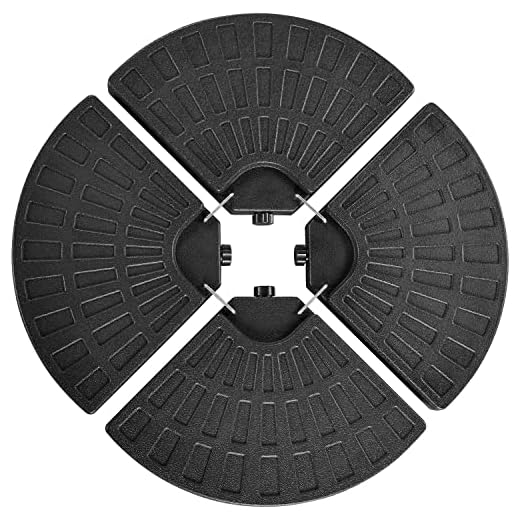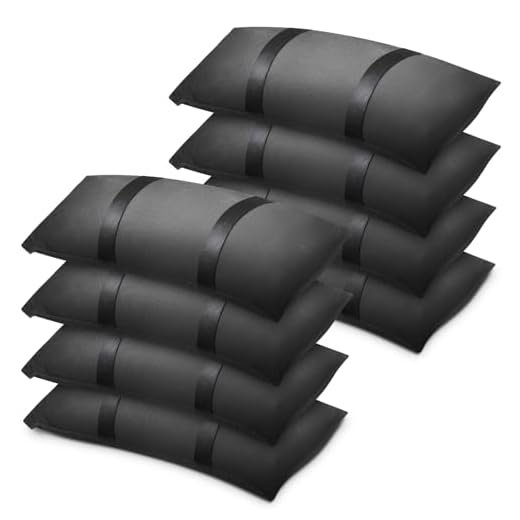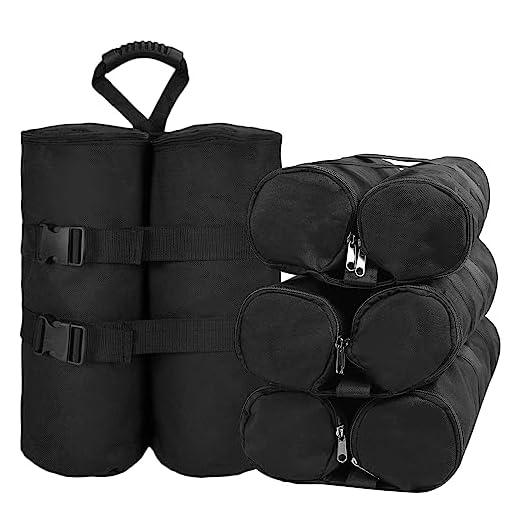




For optimal stability of your outdoor shade structure, consider using heavy-duty bases or weights. This article provides practical solutions for ensuring your canopy remains upright and functional, even in windy conditions.
Homeowners, event planners, and anyone interested in outdoor gatherings will find this information valuable. We’ll explore various options, from water-filled weights to sandbags, and discuss their effectiveness and ease of use.
You will learn the advantages of each method, including how they can enhance safety and prevent damage to your shade device. By the end, you will be equipped with the knowledge to choose the most suitable solution for your needs.
Best Way to Weigh Down Offset Umbrella
To secure a cantilever shade structure effectively, consider using a heavy-duty base or a combination of weights. This ensures stability and prevents tipping, particularly in windy conditions.
One practical option is to fill a base with sand or water. Heavy materials such as concrete blocks or pavers can also be utilized to enhance stability. Always verify that the chosen method does not compromise the integrity of the support system.
Considerations for Stability
- Size of the Base: A larger base provides more surface area for stability.
- Weight Distribution: Evenly distribute weight across the base to avoid tilting.
- Material Quality: Opt for durable materials that can withstand outdoor elements.
In addition to a solid base, utilizing additional weights can offer extra security. Options include:
- Weight bags filled with sand or gravel.
- Stackable concrete blocks for adjustable height.
- Heavy-duty rubber weights specifically designed for outdoor use.
For setups in particularly windy areas, consider anchoring the structure to the ground using stakes or straps. This added measure enhances safety and stability.
Choosing the Right Base Material for Stability
Concrete serves as a highly reliable choice for ensuring stability due to its significant weight and durability. This material not only withstands various weather conditions but also provides a solid foundation that minimizes the risk of tipping over during gusty winds.
Another option is plastic, which, while lighter, can be filled with water or sand to enhance its stability. This versatility makes it easy to transport and store, providing a practical solution for those who may need to relocate their setup frequently.
Factors to Consider
- Weight: Heavier materials like concrete and metal offer superior resistance against strong winds.
- Portability: Lightweight options like filled plastic bases can be advantageous for easy relocation.
- Durability: Selecting materials that withstand environmental exposure ensures longevity.
- Maintenance: Some materials may require regular upkeep, while others are virtually maintenance-free.
In conclusion, selecting the correct material for a supporting base is fundamental for achieving a stable setup. Evaluating the specific needs and conditions will guide the choice that best suits the environment and intended use.
Calculating the Ideal Weight for Your Umbrella Size
Determining the appropriate mass for a shading structure involves several factors, particularly its dimensions. A guideline to follow is that for every foot of canopy diameter, approximately 10 to 15 pounds of mass is recommended for stability. This ensures it remains anchored during breezy conditions.
For instance, if your canopy measures 8 feet across, a base weighing between 80 to 120 pounds is optimal. This calculation allows for a balance between mobility and security, preventing unwanted movement or tipping.
Factors Influencing Weight Requirements
Consider the following elements while calculating:
- Canopy Size: Larger canopies necessitate more stability.
- Wind Conditions: Areas prone to high winds require increased weight.
- Base Design: A wider base can distribute weight more effectively.
Additionally, the material of the base affects its performance. Heavy concrete or sand-filled bases provide solid support, while lighter options may require additional weight to ensure proper function.
Recommended Weight Table
| Canopy Diameter (ft) | Recommended Weight (lbs) |
|---|---|
| 6 | 60 – 90 |
| 8 | 80 – 120 |
| 10 | 100 – 150 |
| 12 | 120 – 180 |
Ensuring the correct mass is critical for safety and functionality. Regularly check the condition of your base to maintain stability over time.
DIY Solutions for Creating Custom Weights
Using concrete blocks is a straightforward method for creating custom weights. These blocks are durable and can be easily arranged to achieve the desired stability. Consider using a mold to shape the concrete into a specific design that fits your needs.
Another practical approach involves filling plastic containers with sand, gravel, or water. These materials are readily available and allow for easy adjustments in weight. Seal the containers tightly to prevent spillage and ensure longevity.
Creative Options for Custom Weights
There are several innovative ideas to consider when crafting your own weights:
- Old Tires: Repurpose old tires by filling them with sand or gravel. This method provides significant weight and can be visually appealing.
- Weighted Bags: Sew or purchase fabric bags that can be filled with rice or beans. This solution is flexible and portable, making it easy to adjust as needed.
- Water Jugs: Use full water jugs as weights; they can be drained or filled according to the required weight. This option offers versatility and is cost-effective.
When creating weights, ensure they are securely fastened to prevent any accidents. Experiment with different materials to find the best balance between functionality and aesthetics.
Common Mistakes to Avoid When Securing Your Canopy Shade
One major error is using insufficient weight. Many individuals underestimate the amount of force required to stabilize their canopy shade, leading to tipping or shifting. Always assess the wind conditions in your area and select a weight that can withstand the local climate.
Another common mistake is relying solely on decorative weights. While they may look appealing, these can often lack the necessary stability. Prioritize functional weights designed specifically for securing outdoor shades, ensuring they can handle various weather conditions.
Additional Errors to Consider
- Improper placement: Distributing weight unevenly can lead to instability. Ensure that weights are evenly spread across the base.
- Neglecting surface conditions: Uneven or soft ground can compromise stability. Always place your setup on a solid surface where possible.
- Ignoring manufacturer guidelines: Each shade might have specific recommendations for stability. Always follow the instructions provided.
Pay attention to these factors to enhance stability and ensure your shade remains secure during use. Avoiding these pitfalls will contribute to a more enjoyable outdoor experience.
Weather Considerations for Securing Your Umbrella
To ensure stability during windy conditions, it’s advisable to assess the surrounding environment. Heavy winds can easily topple a poorly secured canopy. Strategically placing weights or anchors can significantly enhance its resistance against gusts.
Choosing the right materials for securing a canopy is also essential. Opt for durable weights, such as concrete blocks or sandbags, as these provide stability. Additionally, consider the placement of your setup; avoid open areas where wind can gather strength.
Wind and Rain Factors
Wind direction plays a pivotal role in the effectiveness of your support system. Positioning the canopy to face into the wind can reduce the force exerted on it. If rain is expected, ensure that drainage is accounted for to prevent water pooling, which can add unnecessary weight and strain.
- Evaluate local weather forecasts regularly.
- Inspect surrounding structures for potential wind tunnels.
- Consider temporary removal during extreme weather events.
Understanding the specific climate conditions in your area will aid in making informed decisions about securing your canopy. Regular maintenance checks on weights and supports are crucial to ensure longevity and performance.
Maintenance Tips for Long-Lasting Canopy Support
Regular cleaning is essential for prolonging the life of your shade structure. Use a soft brush or cloth along with a mild soap solution to remove dirt and debris. Avoid harsh chemicals that can damage the fabric or frame. Rinse thoroughly with water to eliminate any soap residue.
Inspect the support frame periodically for signs of rust or wear. Apply a rust-inhibiting spray to metal parts to prevent corrosion. Tighten any loose screws or bolts to ensure stability during use. If any components are damaged, replace them promptly to maintain the safety and functionality of your setup.
Additional Care Recommendations
- Storage: Store the canopy indoors during extreme weather conditions to prevent damage.
- Weight Management: Use appropriate weights or sandbags to keep the base secure during windy conditions.
- Fabric Treatment: Apply a fabric protector to enhance water resistance and UV protection.
- Sun Protection: Position the structure away from direct sunlight for extended periods to minimize fading.
By following these maintenance tips, your shading solution will remain functional and visually appealing for many seasons to come.
Best way to weigh down offset umbrella
Features
| Part Number | YT-00102670 |
| Model | YT-00102670G |
| Color | Black |
| Size | 41×41×3in |
Features
| Part Number | YT-00101141 |
| Model | YT-00101141 |
| Color | Black |
| Size | 39.5×39.5×3in |
Features
| Part Number | SKY5897 |
| Model | SKY5897 |
| Color | Black |
| Size | Set of 1 |
Features
| Part Number | FUB41B |
| Model | FUB41B |
| Color | Black |
| Release Date | 2023-12-22T00:00:01Z |
Features
| Part Number | BLUS-15 |
| Model | BLUS-15 |
| Color | Black |
| Size | 8 X 50 lbs |
Features
| Part Number | STJQ-340lbs |
| Model | STJQ-340lbs |
| Color | 340 lbs |
Features
| Part Number | LGBRLABASECROSS |
| Model | 4pcs Cantilever |
| Color | Black-Cross |
| Size | 176lbs |
Video:
FAQ:
What are the best materials to use for weighing down an offset umbrella?
When it comes to weighing down an offset umbrella, several materials can be effective. Common options include concrete, sand, or water-filled weights. Concrete is durable and provides a stable base but can be heavy and difficult to move. Sandbags are a portable option that can be filled to the desired weight, while water weights are easy to fill and drain but may not be as stable in windy conditions. It’s essential to choose a material that suits your specific needs and the environment where the umbrella will be used.
How much weight do I need to safely secure my offset umbrella?
The amount of weight required to secure an offset umbrella typically depends on its size and height. A general guideline is to use at least 100-150 pounds of weight for a standard offset umbrella. Larger umbrellas may require even more weight to ensure stability, especially in windy conditions. It’s advisable to check the manufacturer’s recommendations for specific weight requirements and consider the umbrella’s location to determine the appropriate weight.
Can I use regular patio furniture as weights for my offset umbrella?
Using regular patio furniture as weights for an offset umbrella is possible, but it may not be the most effective solution. While heavy furniture can provide some stability, it might not be secure enough, especially in strong winds. Additionally, furniture can shift or be moved easily, compromising the umbrella’s safety. It’s better to use dedicated weights like sandbags or concrete blocks designed for this purpose to ensure reliable support.
Are there specific weight bases designed for offset umbrellas?
Yes, there are specific weight bases designed for offset umbrellas. These bases are typically made of heavy materials like concrete or metal and are engineered to provide stability. Some designs allow you to fill them with sand or water to adjust the weight as needed. These bases often feature a secure mechanism to hold the umbrella pole in place, ensuring it remains steady even in windy conditions. Investing in a quality weight base can enhance the safety and longevity of your offset umbrella.
What are the signs that my offset umbrella is not securely weighted?
There are several signs that may indicate your offset umbrella is not securely weighted. If you notice it wobbling or leaning to one side, this could mean it lacks sufficient weight. Additionally, if the umbrella tilts or collapses during light winds, it is a clear indication that it needs more weight. Regularly check for any visible signs of strain or movement, especially after storms or windy days, to ensure your umbrella remains securely anchored.









